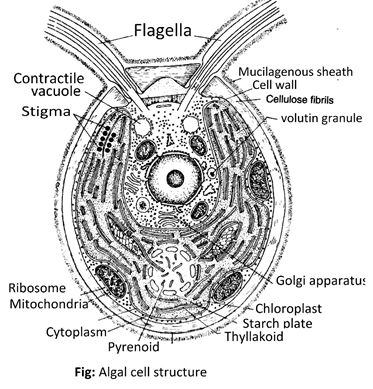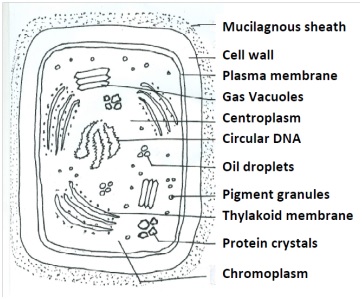There are two basic types of cells in the algae, prokaryotic and eukaryotic. Prokaryotic cells lack membrane-bounded organelles (plastids, mitochondria, nuclei, Golgi bodies, and flagella) and occur in the cyanobacteria. The remainder of the algae are eukaryotic and have organelles.
A eukaryotic cell is often surrounded by a cell wall composed of poly saccharides that are partially produced and secreted by the Golgi body. The plasma membrane (plasmalemma) surrounds the remaining part of the cell; this membrane is a living structure responsible for controlling the influx and outflow of sub stances in the protoplasm. Locomotory organs, the flagella, propel the cell through the medium by their beating. The flagella are enclosed in the plasma membrane and have a specific number and orientation of micro – tubules. The nucleus, which contains the genetic material of the cell, is surrounded by a double membrane with pores in it. The contents of the nucleus are a nucleolus, chromosomes, and the background material or karyolymph. The chloroplasts have membrane sacs called thylakoids that carry out the light reactions of photosynthesis. The thylakoids are embedded in the stroma where the dark reactions of carbon fixation take place. The stroma has small 70S ribosomes, DNA, and in some cases the storage product. Chloroplasts are surrounded by the two membranes of the chloroplast envelope. Sometimes chloroplasts have a dense proteinaceous area, the pyrenoid, which is associated with storage-product formation.
Double-membrane-bounded mitochondria have 70S ribo somes and DNA, and contain the respiratory apparatus. The Golgi body consists of a number of membrane sacs, called cisternae, stacked on top of one another. The Golgi body functions in the pro duction and secretion of polysaccharides. The cytoplasm also contains large 80S ribosomes and lipid bodies.
CELL STRUCTURE
Cells of algae have following important components.
- Cell wall: Cell is surrounded by definite cell wall. Usually cell wall is composed of two layers. The inner layer is firm consisting of microfibrils, Outer layer is gelatinous and amorphous. Various polysaccharides such as cellulose, pectin, mucilage constitute the typical cell wall. Some times cell wall is impregnated with calcium carbonate, iron, silicon etc.
- Cytoplasm: Number of organelles are present in c These organelles are plastids, mitochondria, ribosomes and endoplasmic reticulum.
Eye spot or Stigma; Some motile forms have eye spots. It is sensitive to light and directs the movements of cells in swimming.
- Nucleus: Well defined nucleus is embedded in cytoplasm. It has central or peripheral position. It is composed of chromosomes, nucleoplasm and nucleolus.

Fig: Alge cell structure
PIGMENTS IN ALGAE:
Different groups of algae have different pigments. Pigments are one of the important characteristic in the classification of algae. These pigments are located in plastids and chromatophores.
(a) Chlorophylls:
Five different types of chlorophylls are present in algae, i.e., a, b, c, d and e : Chlorophyll a is present in all algae. Chlorophyll b is present in Chlorophyta and Euglenophyta. Chlorophyll c is present in Bacillariophyta, Chrysophyta etc. Chlorophyll d is present only in Rhodophyta.
(b) Carotenoids
- i) Carotenes: Following five different types are recognized so far, α, β, έ, ϔ and lycopene.
These are present in Bacillariophyta and Rhodophyta and provide them specific colours.
- ii) Xanthophyll: These are yellow to brown colour pigments, e.g., Fucoxanthin (brown algae)
and myxoxanthin (Blue green algae)
(c) Phycobilins: These are phycocyanin (blue) and phycoerythrin (red) which are present in blue green and red algae.
Plastids and Chromatophores: In algae, when chlorophyll pigments are predominating, the plastid body is called chloroplast as in case of Chlorophyceae and Euglenophyceae.
If pigments other than chlorophyll are predominating, they are called chromatophores.
RESERVE FOOD MATERIAL
(a) Carbohydrates: Starches are the main reserve food materials in most of algae, e.g., floridean (red algae), myxophycean (blue green algae), laminarin (diatoms), paramylum (euglenoids) and leucosin (Chrysophyceae).
(b) Fats: Sterols are also reserve food material in many algae (Brown algae).
(c) Alcohol: Mannitol (polyhydroxy alcohol) is present in some brown algae.

